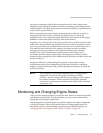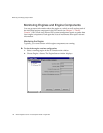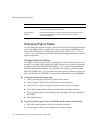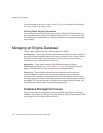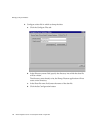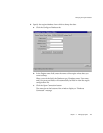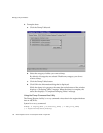Managing an Engine Database
Chapter 4 Managing Engines 125
Growth of the Database
As with any of the enterprise databases used by your workflow application, the
engine database can grow in size. The current state tables grow and shrink in
proportion to the number of sessions, process instances, activities, process
attributes, and timers that exist at any one time. The registration tables are typically
quite small, but grow in proportion to the number of distributions or aliases you
register with the engine.
The history log, however, because it accumulates historical data, can grow quite
large as time goes on, eventually reaching your database storage limit. You must
therefore establish a set of procedures for monitoring and limiting the growth of
the history log. The following suggestions might prove useful:
• Log only the minimum historical data that you will need for process execution
analysis.
See “How to Dynamically Modify Database Logging” on page 115 for history
logging options.
• Maintain an archive history log database.
When rows in your history log tables are sufficiently aged, you can delete them
from the engine database and transfer them to an archive database. For
example, if your system does not make use of long-running process instances,
you might want to periodically transfer all rows in your history log that
correspond to process instances that terminated more than two months ago.
Failure of the Database
For any number of reasons, the engine database might fail. If the engine cannot
access the database (that is, it cannot write to the database), then it raises an
exception and transitions to STANDBY state in which it stops process execution.
Engine exceptions are written to the primary engine unit’s log file and to the iIS
Console Alarms window. See Chapter 7, “Troubleshooting,” for more information
on exceptions.
Recovering Data
When starting an engine, you can choose to recover or lose any existing current
state, registration, or history log database tables, as long as you are not starting the
engine for the first time. The various startup options are described in “How to Start
an Engine” on page 110. When you recover the current state tables you also recover
the registration tables.



